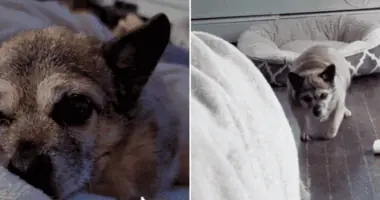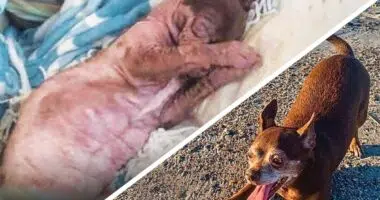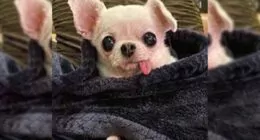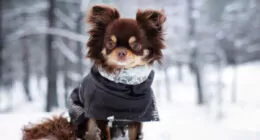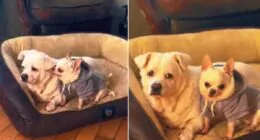According to new research, small dog breeds such as Pomeranians and Chihuahuas are not the result of domestication alone. Chihuahuas share small size gene with ancient wolves. Here are the incredible findings and what they entail.
Scientists have found that an ancient mutation linked to body size was present in wolves over 50,000 years ago. It indicated that nature had been holding onto the mutation until it was needed, making Chihuahuas and wolves share it.
How Chihuahuas Share Small Size Gene with Wolves
A team of researchers from the National Institutes of Health (NIH) collaborated with Greger Larson at the University of Oxford and Laurent Franz at Ludwig Maximilian University to examine the DNA of an ancient Siberian wolf from 54,000 years ago.
They discovered that the IGF-1 mutation, which regulates growth hormones and correlates to dog body size, was present in the wolf’s DNA. This mutation was also found to be consistent across 200 dog breeds.
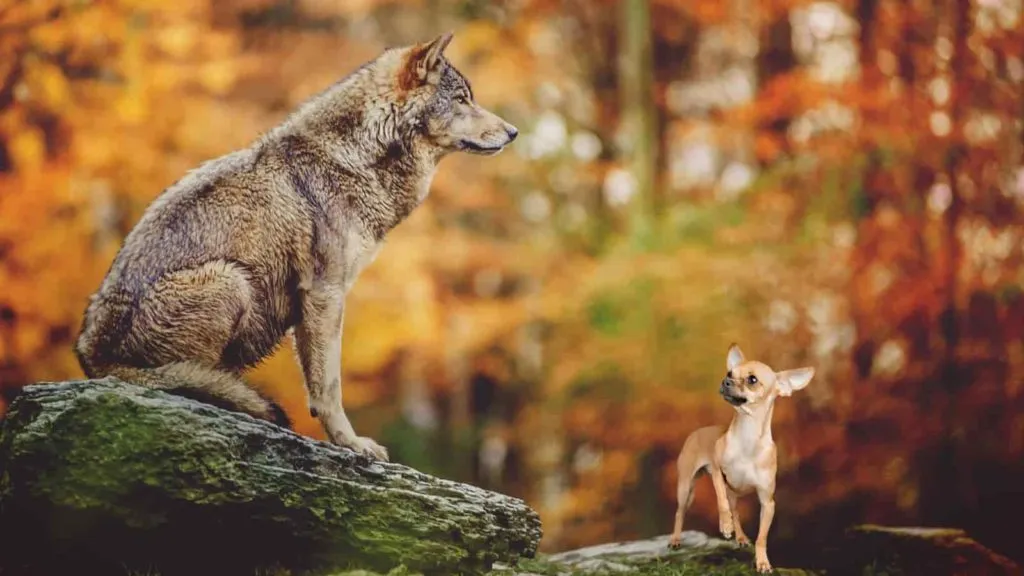 Chihuahua share small size gene with wolves – illustrated by the two on a field
Chihuahua share small size gene with wolves – illustrated by the two on a field
Dr. Elaine Ostrander of the NIH commented: “This is tying together so much about canine domestication and body size. And the things that we think are very modern are actually very ancient.”
The researchers found that the IGF-1 mutation also exists in other canids, such as coyotes, jackals, and African hunting dogs. The study concludes that small dog breeds are not solely the result of human intervention. But, rather a combination of both nature and nurture.
A Tango of Genetics and Human Intervention
Let’s dig a little deeper into this fascinating interplay between nature (genetic factors) and nurture (human intervention). See, the diversity of dog breeds we see today – from the pocket-sized Chihuahuas to the towering Great Danes – is a result of both these elements dancing together in the grand ballroom of evolution.
- Genetic Factors: Nature’s contribution comes in the form of genetic mutations, like the IGF-1 found in ancient wolves. These naturally occurring changes, over time and generations, can lead to significant variations in size, shape, color, and behavior.
- Human Intervention: Enter humans, with our preferences and needs. We took these natural variations and ran with them, selectively breeding dogs for specific traits – be it size, temperament, or ability to perform tasks. This has resulted in the wide array of breeds we are familiar with today.
“This is the beauty of dog evolution – a complex dance between the tunes of nature’s genetic whims and the steps of human needs and desires.”
IGF-1 Mutation in Chihuahuas and Wolves
The discovery of the IGF-1 mutation in ancient wolves challenges the long-held belief that small dog breeds are solely a result of human intervention.
It has been thought that humans domesticated wolves and selectively bred them for smaller sizes to create adorable pets.
Over time, humans have favored smaller dogs for their convenience in domestic environments, selectively breeding for traits like reduced size, tameness, and other desirable physical characteristics inherited from their ancient wolf ancestors.
However, the research suggests that the gene mutation for small body size existed long before humans domesticated dogs.
Get the latest Chihuahua Buzz
The IGF-1 gene is responsible for regulating growth hormones in dogs and other canids. This gene mutation has allowed for the evolution of smaller breeds such as Pomeranians, Chihuahuas, and other toy breeds.
Future Implications of The Study
Dr. Ostrander commented on the study, saying, “It’s really interesting to think about how traits that are selected for can be something that’s already there. In the case of dogs, it’s a gene that’s been around for a very long time and has been selected for in the process of domestication.”
The study also sheds light on the evolution of dogs and their relationships with humans. Domestication of dogs began around 15,000 years ago. Humans have played a role in shaping the physical appearance of dogs over time.
In essence, the evolution of dogs is a harmonious blend of nature doing its thing and humans doing ours. So, go ahead and give your pint-sized Chihuahua, or your towering Great Dane, an extra pat today.
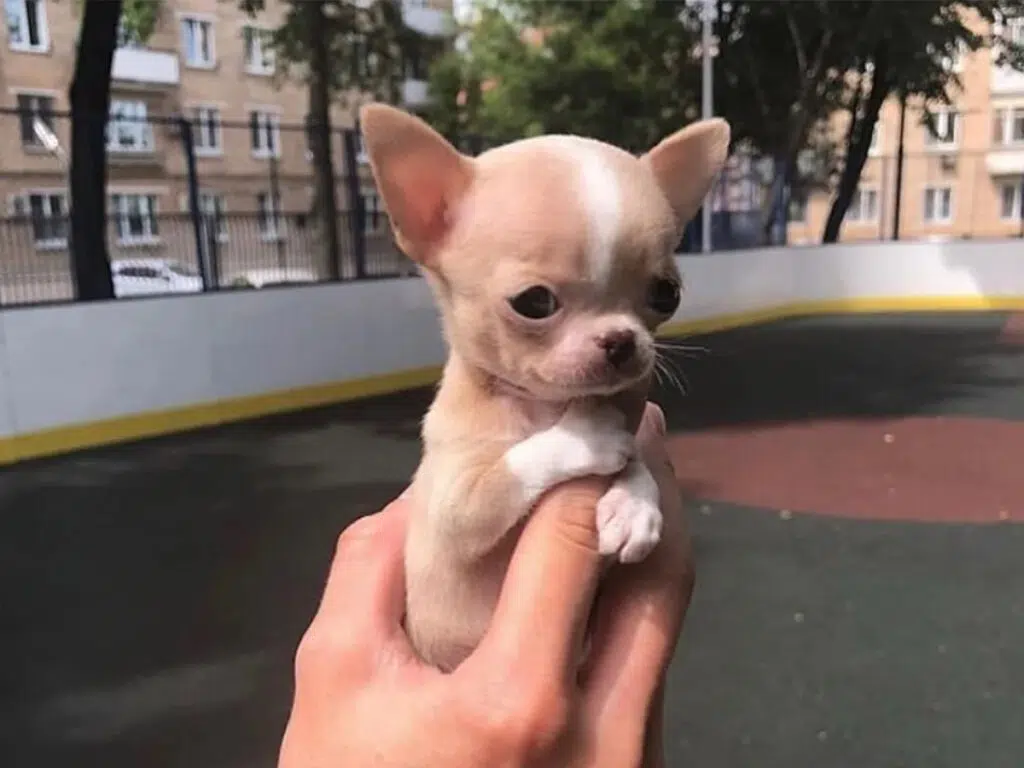
The Future of Dog Breeding
For dog breeders and owners, the implications of this research are potentially transformative. It could assist in making informed decisions about breeding strategies, ensuring healthier puppies, and reducing the incidence of certain genetic disorders.
Identifying the gene responsible for size could also aid in predicting a puppy’s adult size more accurately, ensuring a perfect fit for prospective owners, no matter what their living situation might be.
Health Management
By understanding the genetics behind size, breeders can potentially manage and mitigate health risks associated with particular breeds.
For instance, some large breeds are predisposed to hip dysplasia, while smaller breeds often struggle with breathing issues and dental problems.
A deeper understanding of size genetics could help breeders make more informed decisions to promote the health and longevity of their dogs.
Improved Breeding Strategies
With insights into the genes that determine size, breeders could potentially design breeding strategies to produce healthier puppies.
This could lead to a decrease in certain genetic, neurological and seizure disorders, and an increase in the overall health and vitality of certain breeds.
Perfect Fit
For first-time owners, understanding the genetic basis for a puppy’s size could mean the difference between finding a dog that’s a perfect fit for their home and lifestyle or one that grows to be larger than expected.
This knowledge not only aids in making the right decision when picking a breed but also helps manage expectations and prepare for the future.
Wrapping Up
In conclusion, the discovery of the IGF-1 mutation in ancient wolves offers a twist to the tapestry of canine evolution.
This Chihuahuas and wolves study challenges the traditional notion that we humans were the sole architects, with our selective breeding and favoritism for certain traits, behind the creation of smaller dog breeds like our beloved Chihuahuas.
Instead, this study tosses a bone of mystery into the mix, suggesting that nature had its paw on the blueprint as well.
These pups are the product of millennia of genetic mutations and centuries of human affection and selective breeding. And that’s pretty special, don’t you think?





